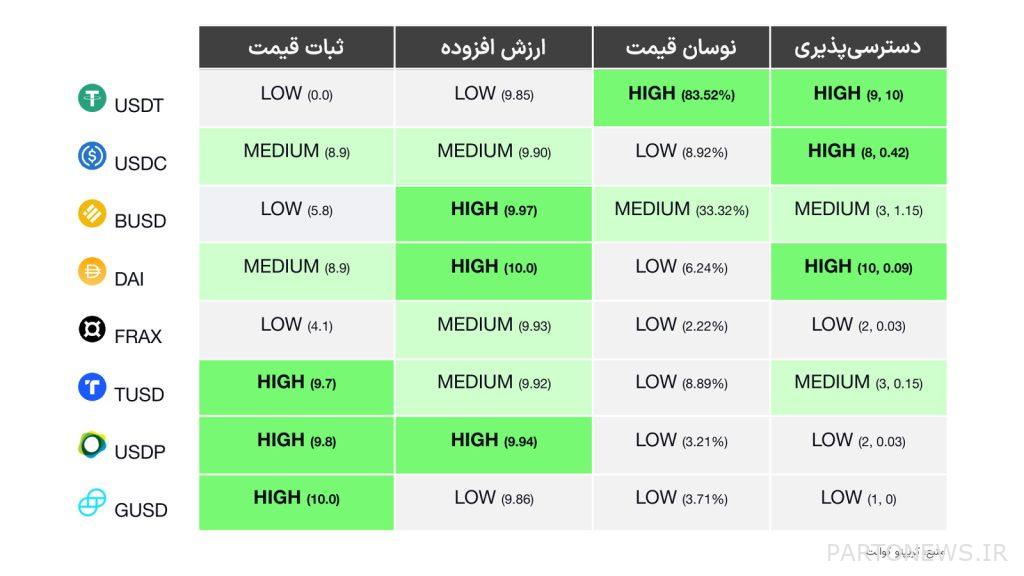Which stablecoins are less risky to hold?

From 2017 to date, all stablecoins except Tether have mostly traded at more than one US dollar. However, not all of these stable digital currencies have the same liquidity, accessibility, price volatility, and value stability. As a trader or investor, looking at these features will help us choose stablecoins with lower risk to hold.
To Report CryptoPotito, a crypto-quant blockchain analytics company recently a report has published that compares data related to various stablecoins and evaluates their value stability. The report shows that almost every current top stablecoin has been marginally more profitable to hold against the US dollar through 2022.
Little added value of stablecoins
According to the report, the daily median closing price (the price at which the daily candle closes) for almost all of the top stablecoins on the market is just over $1. It should be noted that this calculation has been done using the data related to the volume weight of the price of stable coins since 2017.
Dai digital currency (DAI), a stable coin based on the Ethereum network, which has a backing consisting of various assets, has the highest added value among all stable coins. The average final daily price of Dai was 0.40% more than one dollar. After that, Pexos (USDP) and True USD (TUSD) have been trading 0.35 and 0.33% higher than the reference price (one dollar), respectively.
Ki Young Ju, CEO of CryptoQuant, tweeted about this data:
Binance USD (BUSD) seems to be the best option for traders to hold in the long term due to higher closing prices and less periodic drops.
However, Tether (USDT), the largest stablecoin by market capitalization, was the only token that traded primarily for less than $1 during the time frame reviewed in this report. This stablecoin has recorded the largest value decrease among its competitors by recording a significant value difference of minus 4%. Meanwhile, USDC, Tether’s biggest competitor, recorded the most value addition with a closing price of 4% more than $1.
The CryptoQuant report states:
It should be emphasized that most of the deviation from the Tether price below one dollar happened between 2017 and 2019, and since 2020, its average daily closing price has stabilized at almost one dollar.
The price of which stablecoin is more stable than competitors?
This report analyzes the price deviation patterns of various stablecoins dependent on the US dollar over time and specifically measures the price stability (Peg Robustness) of each of them; It means how much the price of each stablecoin deviates from one dollar in turbulent market conditions (where many holders are selling their stablecoins).
According to this report, Gemina USD (GUSD) has the most stable value among all stablecoins. This means that the price of this token has seen little downward fluctuations even in turbulent market conditions.
Meanwhile, Tether has had the least value stability among other stablecoins. In fact, the price deviation of this stable digital currency from one dollar has been large, even compared to the mild selling pressure of the holders.

As this report also explains, a stablecoin is a type of digital currency that is designed so that its price depends on the price of a relatively stable asset. These assets often include fiat currencies; But they can also include commodities such as gold or other financial assets.
Also read: What is Stablecoin or stable digital currency?
Currently, the most popular stablecoins in the market, including Tether, USD Coin and Binance USD, are backed by a one-to-one ratio with the US dollar. Typically, these stablecoins maintain their price stability by using fully backed reserves and easy liquidity. As a result, holders of these digital currencies can redeem their tokens at any time and convert them into dollars.
The now (almost) defunct stablecoin TerraUSD (UST) used a different model to maintain its value. This stablecoin used Luna, which was a volatile digital currency, to maintain its value. With the sharp fall in the value of this stablecoin, it proved that this model is very unstable when subjected to market pressure. It should be noted that the price of both Terra network tokens, Luna and UST, fell in May and reached close to zero.
Of the current top 3 stablecoins, Circle and Paxos, developers of the USDC and USDP tokens respectively, have acknowledged in their recent confirmations that their reserves are fully backed by cash and US Treasuries. Tether is the only group left to publish the second quarter report on the status of its reserves.

